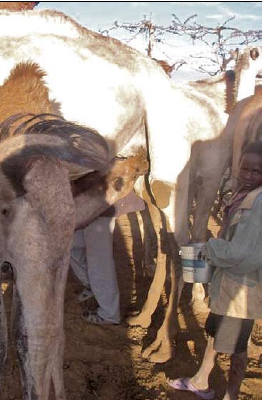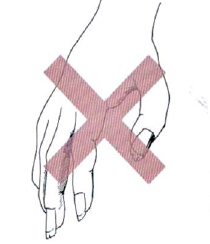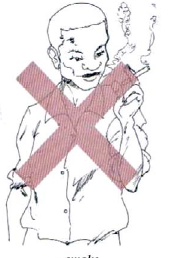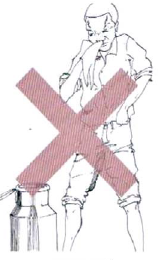1. The animal being milked
The outside of the animal’s udder may have soil, bedding, dust or manure on it. For pastoralists in dry areas where no clean water is available for washing of udders, wiping a dry udder with clean dry hands can reduce the amounts of contaminants on the udder that would otherwise have dropped into the milk. In wetter seasons water should be boiled or disinfected with chlorine and used for washing the udders before milking. Also hairs from the animals coat and swishing tails or dribbles from the mouth of the calf may fall into the milk. Dry scabs or scales of skin especially from animals with skin problems may be another source of contamination.


The inside of the udder may also carry germs, which can come through the teat canals. Usually the first milked out milk has high bacterial counts, while the last milk has a reduced amount. Early mastitis can be detected as it appears as clots in the first 2-3 strips of milk especially from cows and goats. Camels can have hidden (chronic) mastitis, which can only be detected by tests such as CMT (Please see above).
- Ensure milking takes place in a clean, dry place, free of dust and mud,
- Milk healthy animals first,
- Do not mix colostrums (the milk produced the first 7 days after calving) with normal milk.
2. The milker
The person milking animals can be a source of milk contamination. He or she may be ill, or may carry dirt from elsewhere that can contaminate milk.
- People suffering from diarrhea, TB or typhoid should not milk camels or other milking animals. Sick people should get medical treatment and not resume milking until they are fully recovered.
- The person milking animals should NEVER touch urine, retained afterbirth or aborted calves, as these can all transmit Brucellosis and TB both to the person and to the milk shared with other people.
During milking do not:



During milking the milker should NOT have long nails, smoke, sneeze or cough.
3. The environment
Dust and very fine light manure particles can blow into the milk in dry areas. To reduce the dust content of the air at milking:
- Milk in a clean place.
- Sweep the milking area before milking.
- If there is a strong wind, choose a milking area away from the wind.
- Choose milking area away from flies and other insects.
4. The temperature
Good quality milk has a long shelf life at low temperatures (below 5°C) but the higher the temperature milk is kept at, the faster it spoils. Milk stored in the sun in any container will quickly start the process of fermentation – quickest for goat milk, slightly less quick for cow milk and slowest in the case of camel milk. Camel milk can withstand high temperatures for longer than any other types of milk, but if milked 5–6 am even if kept in a clean container the process of fermenting will start 5–6 hours later for camel milk. Keeping the milk protected in shady places will delay this process, and boiling and cooling the milk before sending it, will delay the fermentation process for up to 24 hours.
5. The milking equipment
Equipment and utensils used for milking, storage and transportation of milk may act as major sources of contamination if not well cleaned. The number of utensils used to handle milk between milking and sale to customers should be as few as possible, because the more handling equipment the more sources of contamination.
The traditional wooden or woven milking containers, which are used in pastoral areas, are almost as good and hygienic as modern metal milk cans when they are properly cleaned and smoked. However increasing amounts of non camel keeping customers will not buy smoky tasting milk.
Plastic jerricans are very unhygienic. They cannot be cleaned properly inside. If smoking is tried, they melt where the coals hit the side of the wall. The handles are hollow and can hide a myriad of germs, which no cleaning method can get properly rid of. Though cheap to buy, they are expensive in the long run. Milk traders in Garissa, Kenya buy new ones every 2 weeks, when the old ones break down or become damaged.